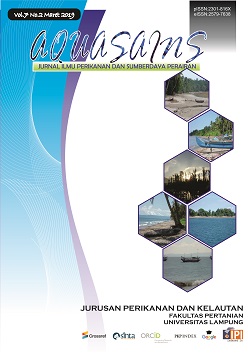HEAVY METAL CADMIUM (Cd) AND LEAD (Pb) IN VANAME SHRIMP (Litopenaeus vannamei) COLLECTED FROM TRADITIONAL MARKETS IN MEDAN CITY, INDONESIA
DOI:
https://doi.org/10.23960/aqs.v7i2.p707-714 Abstract View: 843
Abstract View: 843
Abstract
The presence of heavy metals in the aquatic environment must be monitored continuously. This study aims to determine the amount of heavy metal content of Cadmium (Cd) and Lead (Pb) on Vaname Shrimp (Litopenaeus vannamei). Determining the value of Cadmium (Cd) and Lead (Pb) using an AAS (Atomic Absorption Spectrophotometer) device. It is known that the highest Cd content in the sample 4 (market pancing) which is worth 0.011 mg/kg, and the lowest is in the sample 6 (market sei kambing) which is worth 0.004 mg/kg. The value of the highest Pb value is found in the sample 3 (market merah) worth 0.019 and the lowest value is the sample 5 (market petisah) worth 0.008. So that the results of these tests can be concluded, that the content of heavy metals Cd and Pb in each sample of vaname shrimp is classified as low according to the World Health Organization (WHO), namely the maximum limit of Cd is 5.0 and the maximum limit of Pb is 2.0 while according to EUROPEAN UNION the limit of calcium Cd is 0.2 and the maximum limit of Pb is 0.5 because the vaname shrimp sample is still safe for consumption and can be an export commodity.Downloads
Download data is not yet available.
Downloads
Published
2019-03-31
How to Cite
Yusni, E., & Setiani, T. P. (2019). HEAVY METAL CADMIUM (Cd) AND LEAD (Pb) IN VANAME SHRIMP (Litopenaeus vannamei) COLLECTED FROM TRADITIONAL MARKETS IN MEDAN CITY, INDONESIA. AQUASAINS, 7(2), 707–714. https://doi.org/10.23960/aqs.v7i2.p707-714
Issue
Section
Articles
License
License for Authors
Authors who publish with this journal agree to the following terms:
- Authors retain copyright and grant the journal right of first publication with the work simultaneously licensed under a Creative Commons Attribution License that allows others to share the work with an acknowledgement of the work's authorship and initial publication in this journal.
- Authors are able to enter into separate, additional contractual arrangements for the non-exclusive distribution of the journal's published version of the work (e.g., post it to an institutional repository or publish it in a book), with an acknowledgement of its initial publication in this journal.
- When the article is accepted for publication, its copyright is transferred to Aquasains Journal. The copyright transfer convers the exclusive right to reproduce and distribute the article, including offprint, translation, photographic reproduction, microfilm, electronic material, (offline or online) or any other reproduction of similar nature.
- Authors are permitted and encouraged to post their work online (e.g., in institutional repositories or on their website) prior to and during the submission process, as it can lead to productive exchanges, as well as earlier and greater citation of published work (See The Effect of Open Access).
- The Author warrant that this article is original and that the author has full power to publish. The author sign for and accepts responsibility for releasing this material on behalf os any and all-author. If the article based on or part os student’s thesis, the student needs to sign as his/her agreement that his/her works is going published.
License for Regular Users
Other regular users who want to cite, distribute, remix, tweak, and build upon author’s works, even for commercial purposes, should acknowledge the work’s authorship and initial publication in this journal, licensed under a Creative Commons Attribution License.
This license lets others distribute, remix, tweak, and build upon your work, even commercially, as long as they credit you for the original creation.
This work is licensed under a Creative Commons Attribution 4.0 International License.Copyright Transfer Statement can be downloaded here


.png)









